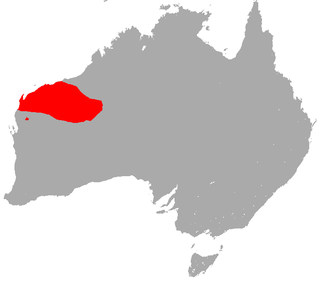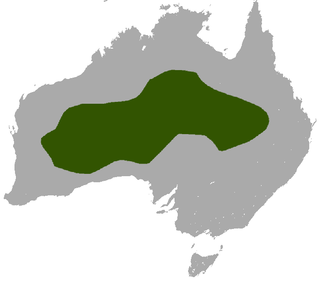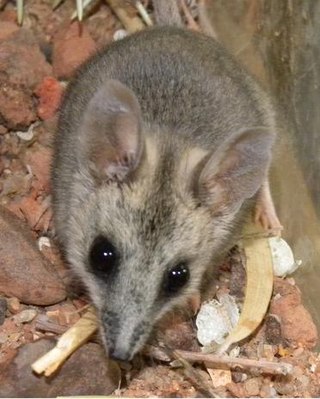
The Dasyuridae are a family of marsupials native to Australia and New Guinea, including 71 extant species divided into 17 genera. Many are small and mouse-like or shrew-like, giving some of them the name marsupial mice or marsupial shrews, but the group also includes the cat-sized quolls, as well as the Tasmanian devil and the extinct thylacine. They are found in a wide range of habitats, including grassland, underground, forests, and mountains, and some species are arboreal or semiaquatic. The Dasyuridae are often called the 'marsupial carnivores', as most members of the family are insectivores.
The former subfamily Planigalinae contained the planigales and the ningauis: very small marsupial carnivores native to Australia which are, like the quolls, antechinuses, dibblers, Tasmanian devil, and many others, part of the biological order Dasyuromorphia: the carnivorous marsupials. The subfamily is now contained in the Sminthopsinae subfamily, and the two genera are split between two different tribes; the planigales are by themselves in their own tribe, while the ningaui are lumped with the dunnarts and the Kultarr.

The common planigale, also known as the pygmy planigale or the coastal planigale, is one of many small marsupial carnivores known as "marsupial mice" found in Australia. There they fill a similar niche to the insectivores of other parts of the world.

The little red kaluta is a small, reddish-brown, shrew-like mammal native to dry grasslands of northwest Australia. It is active at night, feeding on insects and other small animals. The kaluta is a marsupial and is the only member of its genus, Dasykaluta. Individuals are around 10 cm (3.9 in) long and weigh from 20 to 40 g. They live for about four years in captivity. Other common names include little red antechinus, russet antechinus and spinifex antechinus.

The Wongai ningaui is a tiny carnivorous marsupial native to the arid open grasslands of inland Australia. Their diet is mainly small insects, and occasionally larger prey such as spiders, grasshoppers and cockroaches, which they forage for at the ground and in clumps of spinifex. They have long and untidy fur, grey or gingery brown with longer black hairs, small ears, a narrow muzzle, and possess a partially prehensile tail and feet that allow them to climb. The population occurs sparsely across a wide area and common in favourable habitat, especially in years of good rainfall. Ningaui ridei was first described in 1975, one of two species of a new genus discovered amongst the poorly known mammals of the western regions of Australia.

Antechinus is a genus of small dasyurid marsupial endemic to Australia. They resemble mice with the bristly fur of shrews.

The kultarr is a small insectivorous nocturnal marsupial inhabiting the arid interior of Australia. Preferred habitat includes stony deserts, shrubland, woodland, grassland and open plains. The kultarr has a range of adaptations to help cope with Australia's harsh arid environment including torpor similar to hibernation that helps conserve energy. The species has declined across its former range since European settlement due to changes in land management practices and introduced predators.

The striped-faced dunnart is a small, Australian, nocturnal, "marsupial mouse," part of the family Dasyuridae. The species' distribution occurs throughout much of inland central and northern Australia, occupying a range of arid and semi-arid habitats.

The Julia Creek dunnart is a marsupial with a buffy brown upperside and white underside. This dunnart has a body length of 100–135 mm with a tail of 60–105 mm to make a total length of 160–240 mm. Its weight is between 40 and 70 g. The length of the hind foot is 22–24 mm. The species has a dark brown triangle colour from above and below the eye with the point at the nose, and another dark stripe on top of the skull. A healthy dunnart has a carrot-shaped tail filled with fat stores.

Rory Cooper's false antechinus, also known as the tan false antechinus and the tan pseudantechinus, is a recently named species of small carnivorous marsupial which inhabits rocky outcrops in Western Australia. Nothing is known of its behaviour but it is expected that this will be similar to other members of the false antechinus genus. A study published in 2017 found no support for separation as a new species of Pseudantechinus, and the name was proposed to be synonymous with the previously described Pseudantechinus macdonnellensis.

The Pilbara ningaui, sometimes known as Ealey's ningaui, is a tiny species of marsupial carnivore found in Australia.

Ningaui is a genus of small species of the marsupial dasyurid family. Along with the planigales, they are among the smallest marsupials.

The sandhill dunnart is a species of small carnivorous Australian marsupial of the family Dasyuridae. It is known from four scattered arid areas of Australia: near Lake Amadeus in Northern Territory, the central Eyre Peninsula in South Australia, the southwestern edge of the Great Victoria Desert in Western Australia, and at Yellabinna in South Australia.

The narrow-nosed planigale is a species of very small marsupial carnivore of the family Dasyuridae.

The western pygmy possum, also known as the southwestern pygmy possum or the mundarda, is a small marsupial found in Australia. Genetic studies indicate its closest relative is probably the eastern pygmy possum, from which its ancestors diverged around eight million years ago.

The northern marsupial mole or kakarratul is a marsupial in the family Notoryctidae, an endemic animal of arid regions of Central Australia. It lives in the loose sand of dunes and river plains in the desert, spending nearly its entire life beneath ground. The facial features are reduced or absent, their small and strong body, weighing little more the 30 grams, is extremely specialised to moving through sand in search of prey. The species is elusive and it is one of the most poorly understood mammals of Australia.

The brush-tailed mulgara, previously the mulgara Dasycercus cristicauda, is a medium sized carnivorous Australian marsupial species weighing approximately 100 g (3.5 oz). The brush-tailed mulgara is sexually dimorphic with males being much larger than females. Their body length is 12 to 17 cm, and tail length is 6–10 cm (2.4–3.9 in). They store fat in their tail which at times can be over 16 mm (0.63 in) wide at the base.
Eric Herbert Mitchell "Tim" Ealey, 29 March 1927 - 21 October 2020, was an Australian biologist, known for his contributions to science, the environment and conservation awareness and was the recipient of a Medal of the Order of Australia. Ealey has received international recognition for his works, and nationally acknowledged for a program that involved schools in rehabilitation of the environment. Ealey was commemorated in the specific epithet of a tiny marsupial, Ningaui timealeyi, he discovered in the Pilbara region of Western Australia. Amongst his works was research on the monotreme family of Tachyglossidae, the species of echidnas. Ealey worked for the Antarctic Division in the 1950s, researching the fauna of Heard Island. The Ealey Glacier there is named after him.
Triodia irritans is a species of plant that forms low and dense mounds of tough grassy vegetation. It is found on sandplains in arid regions of southern and central Australia.
The orange-headed Pilbara planigale, formerly known as Planigale 1, is a species of planigale first described in 2023, and is one of the smallest of all mammals. The orange-headed Pilbara planigale lives in the Pilbara region of Western Australia, where it co-occurs with the similar and also newly recognised cracking-clay Pilbara planigale. Both species had historically been mistaken for either the common planigale, or long-tailed planigale, neither of which are now known to occur in the Pilbara.


















